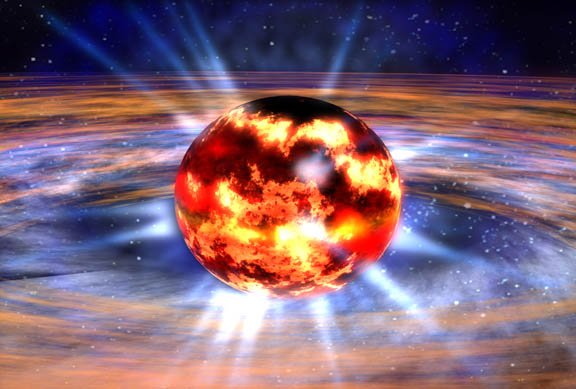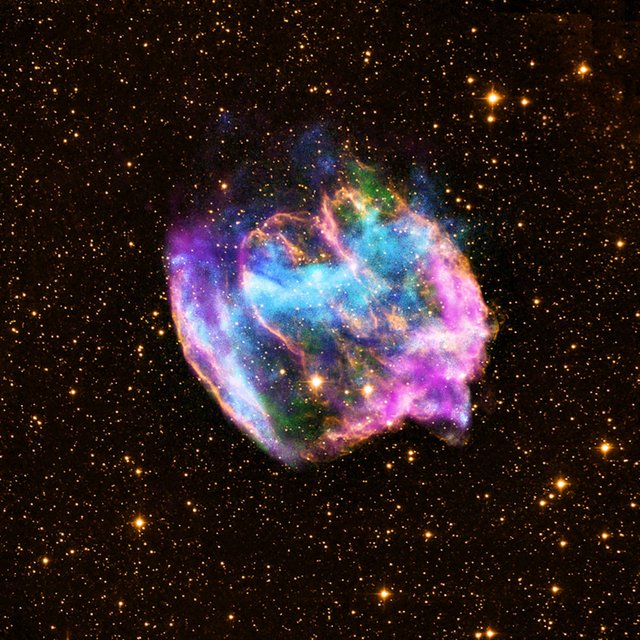Neutron Stars
Neutron stars are some of the densest objects in the universe.
Neutron stars were discovered in 1967 by Jocelyn Bell. He was studying distant radio sources at Cambridge University. He found that the radio signal pulsed every 1.33728 seconds nonstop. They were eventually names pulsars, short for pulsating radio signals. Soon scientists found these all over, but still couldn’t find a source. Eventually the first neutron star was seen in the Crab Nebula. [1]
Properties of Neutron Stars
Neutron stars have some of the strangest properties out of any type of star. We still don’t fully understand them, they are an area of active research.
Neutrons
A neutron stars are called a neutron stars for a reason. At the center of a neutron star the pressure is so intense that electrons and protons merge to become neutrons. Around 90% of a neutron star’s mass is made up of neutrons.[2]
Neutrons also keep the star from collapsing. Particles within the same volume can not have the same energy level. As neutrons get pushed together the new neutrons must reach higher and higher energy levels. This creates an outward pressure that counteracts gravity. [3]
Gravity
A neutron star is extremely dense. They are only about 20 kilometers across and have a theoretical upper mass limit of 3 times that of our sun. To put this in perspective a single teaspoon would weigh more than a billion tons. The gravitational lensing around a neutron star is strong enough for astronomers to see the back of the star.[4]
Spin
Neutron stars spin extremely quickly, as fast as 43,000 times per minute. The supernova that creates the neutron star also gives it huge amounts of energy. This energy combined with how small the star is allows it to reach these speeds. This spin combined with the radiation some of them give off at its poles is what originally gave them the name pulsars. [5]
Magnetic Fields
The average neutron star has a magnetic field trillions of times stronger than Earth’s. A neutron star can support this because of its strong gravity. These massive fields can get intertwined and snap to release huge amounts of energy. The neutron stars with the strongest fields, called magnetars, can release as much energy in half a second as our sun releases in 100,000 years.[6]
Creation of Neutron Stars
Neutron stars are created in type II supernova. Type II supernova happen when a star runs out of other elements to fuse and starts fusing iron. Stars need pressure from fusion to stop from collapsing. Fusing iron takes more energy than it produces. This causes the star to collapse almost instantly. The increased pressure ignites the outer core and the star then explodes outward. What is left is an extremely dense core. A star must be between 10 and 29 solar masses for this core to turn into a neutron star. Any more and it is a black hole and any less it will become a white dwarf.[7]
Neutron stars are some of the weirdest objects in the universe. The only thing stopping them from becoming a black hole is strange quantum mechanical processes.
Want to learn more about science? Subscribe and upvote!
[1]source
[2]source
[3]source
[4]source
[5]source
[6]source
[7]source


I was surprised with all the information you provided, my friend. Little had heard of neutron stars. Thank you very much for sharing and I hope you have a beautiful weekend.
your comment has over twice the upvotes of my post
These posts you are making are so interesting and truly informative. Thank you!
"Gravitational lensing is so strong, we can see the back of the star"
This is true for black holes as well, when we look straight at a black hole, the em radiation coming to our eyes may not be coming in a straight path, they may get curved so much that the "stuff" behind the black hole would appear to us, and our night sky would contain two copies of the body, a result of light curving in different paths around the black hole
Cool!
Space is beautiful
Very interesting!